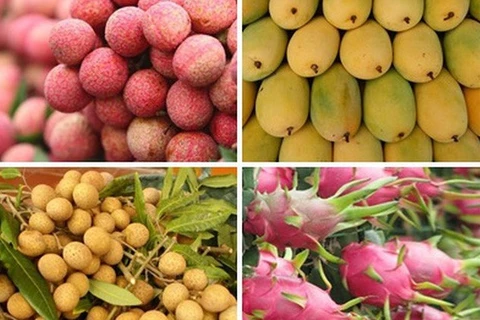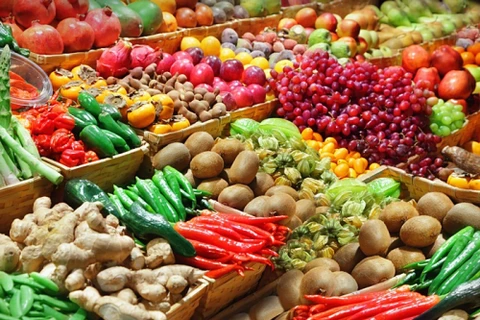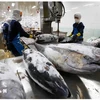 Representatives of the Hanoi Department of Industry and Trade visit a regional trade fair for farm produce in the capital. (Photo: Duc Duy/Vietnam+)
Representatives of the Hanoi Department of Industry and Trade visit a regional trade fair for farm produce in the capital. (Photo: Duc Duy/Vietnam+) VNA (Hanoi) - To ensure successful crops, the Ministry of Industry and Trade is urging relevant departments to keep track of agricultural products and fruits that are currently in harvest season and to maintain regular communication with businesses to understand the demand for consumption support.
To increase the consumption of in-season fruits such as lychee, longan, and mango, the Ministry of Industry and Trade is collaborating with other ministries, relevant departments, and localities to promote trade promotion activities in both domestic and international markets.
The diversification of markets has been a key factor in the increased export values of fruit businesses. By expanding their reach beyond traditional markets and exploring new opportunities, fruit businesses have been able to tap into growing demand and increase their profits.
The Ministry of Industry and Trade said it will continue supporting these efforts through trade promotion activities and other measures to help fruit businesses thrive.
Ready for bumper crops
The northern provinces of Bac Giang, Hai Duong, and Hung Yen are expecting bumper crops of fruits in the upcoming harvest season.
According to Tran Quang Tan, Director of Bac Giang Department of Industry and Trade, the province is expected to produce over 180,000 tons of lychee in 2023, with China being the traditional market and other potential markets such as the United States, the European Union (EU), Japan, and other countries in Asia and the Middle East.
Similarly, Hai Duong province is home to nearly 9,000 hectares of lychee, with early-ripen lychee accounting for about 30% and the main season making up 70%. This year, the province is expected to produce about 61,000 tons of the fruit. Meeting the VietGap and GlobalGAP standards, most of the local fruit are eligible for export to high-end markets.
The province has more than 200 growing area codes and 21 packaging establishments for export to markets like China, the United States, Australia, New Zealand, Japan, and Thailand.
 Lychee is being strongly promoted for consumption by retailers and supermarkets. (Photo: Duc Duy/Vietnam+)
Lychee is being strongly promoted for consumption by retailers and supermarkets. (Photo: Duc Duy/Vietnam+) Meanwhile, according to a report from Hung Yen province, the locality is expected to have 1,100 hectares of lychee with an output of about 12,700 tons, and over 4,730 hectares of longan yielding 45,000 tons a year.
Trade promotion and supply-demand connection activities have been strongly carried out by localities across the province, with a focus on longan consumption promotion.
Expanding markets, increasing exports
According to the Ministry of Agriculture and Rural Development, the estimated fruit output in the second quarter of 2023 in Vietnam is over 2.6 million tons, including 330,000 tons of lychee, 110,000 tons of longan, and hundreds of thousands of tons of pineapple, mango, orange, and dragon fruit.
Deputy Minister of Industry and Trade Do Thang Hai stated that Vietnam’s fresh lychee products have been exported to 30 markets, including China, the US, the EU, Japan, and the Republic of Korea, among others. The number of export markets is continuously expanding, he said.
 Fruits from different localities nationwide are promoted among Hanoi consumers. (Photo: Duc Duy/Vietnam+)
Fruits from different localities nationwide are promoted among Hanoi consumers. (Photo: Duc Duy/Vietnam+) Despite this advantage, the abundance of supply is putting great pressure on consumption, with exports in many markets dropping sharply and domestic demand being limited.
China remains Vietnam’s largest traditional market with the highest demand, but it has increasingly enhanced requirements for quality, quarantine, labeling, packaging, and related regulations on traceability, preservation, shipping, and payment.
Therefore, to ensure successful harvests, the Ministry of Industry and Trade should keep up-to-date monitor on agricultural products and fruits that are in the harvest season, and conduct regular exchanges with businesses to help them in exports activities./.






















